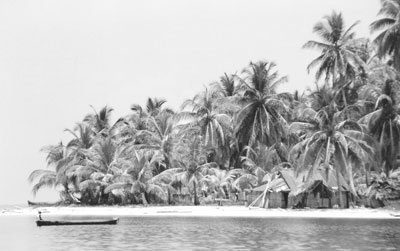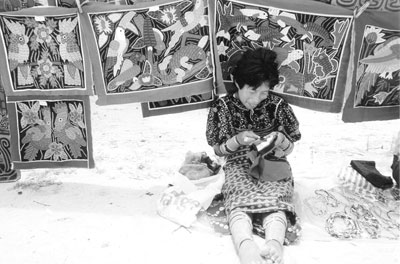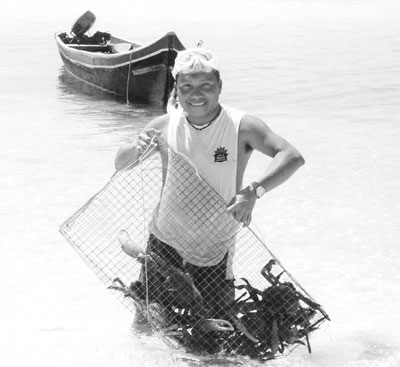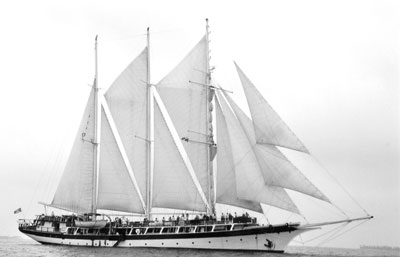Kick off your shoes & enjoy a Barefoot San Blas Islands cruise
by Larry Taylor, Fullerton, CA
The San Blas Islands, off the coast of Panama, are one of the last pristine, undeveloped areas of the world. These islands, with swaying coconut palms, soft sand beaches and colorful coral reefs surrounded by the turquoise Caribbean, are the epitome of a tropical paradise.
The name San Blas was only vaguely familiar to my wife and me when we read that Windjammer Barefoot Cruises (Miami Beach, FL; phone 800/327-2601 or visit www.windjammer.com) was going to add this destination their 2003 offerings. Reading the brochure’s promise of learning about an exotic culture, coupled with visiting uninhabited islands with ample beach and snorkeling time, we decided to sign up for a week-long September ’03 cruise on the SV Mandalay.
Panama
Grupo TACA airlines offered direct flights to Panama from our home base, Los Angeles, leaving around 1 a.m. Not feeling up to a red-eye, however, we opted for a one-stop Delta flight that left at a more civilized time.
After our evening arrival in Panama City, we were transferred to the Country Inn & Suites at the end of the Panama Canal and adjacent to the oft-photographed Bridge of the Americas, where we had a great view of ships entering the Pacific Ocean after passing through the canal’s locks.
The next morning, before boarding ship, passengers were taken on a city tour highlighted by a stop at Panama’s Old City, built by 16th-century Spanish conquerors. We walked down the original cobblestone road viewing the remnants of the ancient fort and cathedral.
Later we visited the U.S. government enclave which housed the administration and workers in charge of the construction of the canal. Nearby are the Panama Canal Museum and Plaza Francia, the site of a monument dedicated to workers, mostly French, who died building the canal.
In the afternoon, on our way to Portobello where the Mandalay was anchored, our group stopped at the Miraflores Locks, the last stop for ships on their day-long canal journey from the Atlantic to the Pacific. By late afternoon we were on board the Mandalay, ready to set sail that night.
The ship
The Windjammer fleet, established in 1947 by Navy vet Mike Burke, consists of six tall-masted sailing ships, many of which were built before WWII. This was the era of graceful yachts owned by the rich and famous.
The Mandalay was built in 1923 by financier E.F. Hutton. In 1953 she became a floating laboratory for Columbia University, sailing over a million-and-a-quarter miles worldwide. The ship became part of Windjammer’s fleet in 1982.
With 36 cabins, the Mandalay can accommodate 72 passengers and is served by a crew of 30. Other Windjammer ships are similar in size, with the largest, the SV Legacy, holding 128 guests.
These spiffy vessels were built by expert craftsmen using exotic hand-carved woods. It’s a sensuous experience to feel weathered teakwood under your feet.
Although from another era, each ship incorporates the latest navigation and communications systems.
Because Windjammer ships draw less water than large cruise ships, it’s easy for them to get close to the smallest islands and out-of-the-way ports. This aspect made the Mandalay perfect for visiting the San Blas Islands. We could anchor close to shore, minutes away by tender from the beach.
Setting sail
Around 10 p.m. Sunday night, we raised sails and were underway. Helping out is not mandatory, but many chose to “heave away” with the crew, becoming a more integral part of the experience. Meanwhile, the strains of “Amazing Grace” swelled from speakers on deck. No matter how many times we witnessed this ritual, it still sent shivers up our spines.
As expected with a yacht this size, cabins were efficiently compact. Standard cabins had bunk beds, a bathroom/shower and enough storage space for a week’s worth of shorts and T-shirts. Of course, no hard shoes were permitted on board.
The cruise atmosphere could not have been more laid-back.
When we awoke our first morning, we peeked through the window of our deck cabin and saw our first destination, Achu Tupi, or Dog Island. With sheltering reef and palm-fringed beach, it looked as close to paradise as we could get.
Following breakfast on this and every day, Captain’s Story Time took place on the top deck, during which Captain Matt enthusiastically informed passengers of the day’s activities and about the islands we would visit. With clear weather and balmy breezes beckoning, we couldn’t wait to get ashore.
The islands and their people
San Blas is an archipelago consisting of over 365 islands, many postage-stamp sized, with the biggest island we saw seemingly not more than a couple miles around. Most are uninhabited; some are home to one or two Kuna Indian families.
The largest island on our itinerary was Nalunega, consisting of a small village with a rustic hotel. Here we gathered in a large meeting hall and met local chiefs swinging in their hammock thrones.
During the week, we had on board a Kuna Indian translator, Gilberto Alamencia, who filled us in on local history and culture. He said that the Indians retreated to the islands from the mainland in the early 1600s after the Spanish invasion of Panama.
There are now some 53,000 Kunas living on the islands and on a strip of land on the Panamanian coast. The Kuna area has been designated a semiautonomous territory, not unlike a U.S. Indian reservation.
On the islands, the people live much as their ancestors did in palm-thatched huts with no electricity. Water is brought in from the coast a few miles away, supplemented by rainwater. Seafood and coconuts are the staples of their diet.
Proving that civilization hasn’t totally passed the islanders by, however, we saw a group of Kunas on one very small island sitting in front of a hut listening to a transistor-radio broadcast of a mainland soccer game.
Kuna women are known for their colorful costumes, which consist of patterned blue cotton wrapped skirts, red and yellow head scarves, arm and leg beads and intricately sewn mola-paneled blouses.
The molas are handwoven in a reverse appliqué technique using several layers of differently colored cotton. (Four-layered designs are considered the best.) They are usually decorated with fine embroidery depicting such things as animals, mythic characters and folk symbols. Molas developed when Kuna women gained access to store-bought goods. Men have also become mola artisans.
These mola panels, most about a foot square, have become sought-after examples of folk art, and the selling of them has contributed much to the Kuna economy. They average around $10 each, but we saw some that sold for $80.
Every day women set up displays of them on the beach. “Mola malls,” passengers called them. Often we saw the same purveyors as they followed us from island to island.
Island activities
Each day we had prime beach time for sunbathing, snorkeling, kayaking or simply reading a book in the shade of a coconut palm. Often tables were set up for a lunchtime barbecue or buffet.
As expected, snorkeling was great. We saw some of the loveliest coral gardens imaginable in all colors: reds, greens, yellows and blues. Leafy coral trees swayed in the current; large mounds of brain coral loomed before us, and fire coral beckoned, but we dared not touch.
All this abundant growth attracted swarms of tropical fish in a rainbow of shades. A highlight one day was the sight of a 6-foot-long nurse shark napping under a reef ledge.
Onboard food and fun
Back on the ship, rum swizzles and appetizers were served on the top deck followed by two seatings for dinner, at 6:30 and 8. It was amazing what items head chef “Boston” and his 3-man crew were able to create in the ship’s closet-sized kitchen. Fresh fish prepared in a variety of ways was often one of the two entrée selections, paired with chicken, pork or beef dishes. Two of our favorite sides were prepared with fresh grated ginger — a very light cole slaw and an equally interesting carrot salad.
Each day Kuna fishermen would meet us ashore or come alongside the ship, their dugout canoes filled with lobsters and crabs. Although we had no complaints about the food on board, some of us couldn’t resist the temptation of fresh shellfish. One day I bought a large king crab for $4 which the cooks obligingly steamed. Without a doubt, it was the most delicious crab I’ve ever eaten, and there was so much I couldn’t finish it.
There were no entertainers on board as on big cruise lines, but we never lacked for diversion. One night, a costume party was held. Passengers and crew were encouraged to dress in something starting with the letter “p.” This resulted in a surfeit of pirates, pimps and cross-dressed prostitutes, good for lots of laughs. Another night, races with hermit crabs were held.
Capt. Matt Thomas has been with Windjammer for 20 years, having worked his way up from a young deckhand. Each sailing, he sees a lot of familiar faces because of the 65% return rate of passengers.
We talked to many people who had sailed with Windjammer multiple times. It was one couple’s 11th trip. What they love is the casual, unpretentious atmosphere on board, and the fact that there is something new happening each day.
The Mandalay was in San Blas from summer to the end of September before sailing east for winter and spring cruises out of Grenada. According to Thomas, this initial season had been a success. He said, “The word from the front office is that we’ll be back in Panama late next spring.” I certainly hope so.
This was one of our most rewarding cruise experiences. We learned a lot and had loads of fun.




